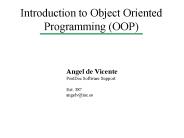Object Oriented Programming Through C++ - PowerPoint PPT Presentation
Title:
Object Oriented Programming Through C++
Description:
Object-oriented programming aims to implement real-world entities like inheritance, hiding, polymorphism, etc in programming. This PPT consists of the main concepts of object-oriented programming through C++. – PowerPoint PPT presentation
Number of Views:386
Title: Object Oriented Programming Through C++
1
Object Oriented Programming With C
2
CONTENT
- What is OOPs?
- Concepts Of OOPs
- Class
- Objects
- Encapsulation
- Abstraction
- Polymorphism
- Inheritance
3
What is OOPs?
Object-oriented programming As the name
suggests uses objects in programming.
Object-oriented programming aims to implement
real-world entities like inheritance, hiding,
polymorphism, etc in programming. The main aim of
OOP is to bind together the data and the
functions that operate on them so that no other
part of the code can access this data except that
function.
4
(No Transcript)
5
Class
The building block of C that leads to
Object-Oriented programming is a Class. It is a
user-defined data type, which holds its own data
members and member functions, which can be
accessed and used by creating an instance of that
class. A class is like a blueprint for an
object. For Example-Consider the Class of Cars.
There may be many cars with different names and
brand but all of them will share some common
properties like all of them will have 4 wheels,
Speed Limit, Mileage range etc. So here, Car is
the class and wheels, speed limits, mileage are
their properties.
6
Objects
An Object is an identifiable entity with some
characteristics and behaviour. An Object is an
instance of a Class. When a class is defined, no
memory is allocated but when it is instantiated
(i.e. an object is created) memory is
allocated. Object take up space in memory and
have an associated address like a record in
pascal or structure or union in C. When a
program is executed the objects interact by
sending messages to one another.
7
Encapsulation
Encapsulation is defined as wrapping up of data
and information under a single unit. In
Object-Oriented Programming, Encapsulation is
defined as binding together the data and the
functions that manipulate them. Encapsulation
also leads to data abstraction or hiding. As
using encapsulation also hides the data. In the
above example, the data of any of the section
like sales, finance or accounts are hidden from
any other section
Methods
Variables
Encapsulation in C
Class
8
Abstraction
Data abstraction is one of the most essential
and important features of object-oriented
programming in C. Abstraction means displaying
only essential information and hiding the
details. Data abstraction refers to providing
only essential information about the data to the
outside world, hiding the background details or
implementation. For example A man driving a
car. The man only knows that pressing the
accelerators will increase the speed of car or
applying brakes will stop the car but he does not
know about how on pressing accelerator the speed
is actually increasing, he does not know about
the inner mechanism of the car or the
implementation of accelerator, brakes etc in the
car. This is what abstraction is.
9
Polymorphism
- The word polymorphism means having many forms. In
simple words, we can define polymorphism as the
ability of a message to be displayed in more than
one form. - A person at the same time can have different
characteristic. Like a man at the same time is a
father, a husband, an employee. So the same
person posses different behavior in different
situations. This is called polymorphism. - C supports operator overloading and function
overloading. - Operator Overloading The process of making an
operator to exhibit different behaviours in
different instances is known as operator
overloading. - Function Overloading Function overloading is
using a single function name to perform different
types of tasks. - Polymorphism is extensively used in implementing
inheritance.
10
Inheritance
The capability of a class to derive properties
and characteristics from another class is called
Inheritance. Inheritance is one of the most
important features of Object-Oriented
Programming. Sub Class The class that inherits
properties from another class is called Sub class
or Derived Class. Super Class The class whose
properties are inherited by sub class is called
Base Class or Super class. Reusability If we
want to create a new class and there is already a
class that includes some of the code that we
want, we can derive our new class from the
existing class. By doing this, we are reusing the
fields and methods of the existing class.
11
Thank you































